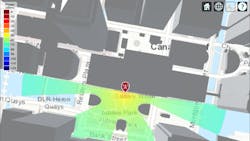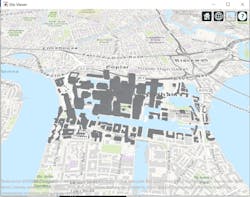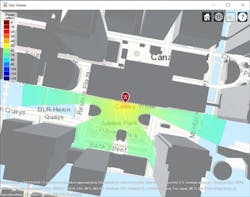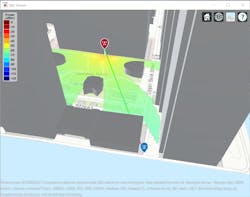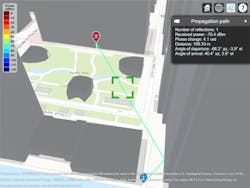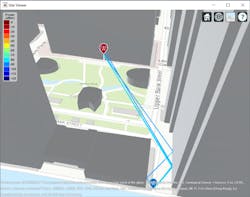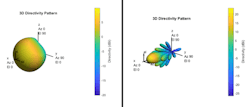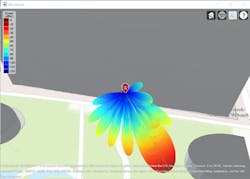Algorithms to Antenna: Analyze 5G Urban Scenarios with Ray Tracing
In past blogs, we described ways you can analyze and visualize coverage maps for wireless communications and radar applications. Those techniques focused on terrain-based maps. In the wireless example, we showed how you can determine whether a signal path exists between a transmitter and a receiver. To help with planning radar locations, we also showed how this workflow extends to plotting signal-to-noise ratio (SNR) over terrain to see where a radar is most likely to detect a target.
In this blog, we’ll explain how you can use ray tracing to analyze 5G communication links in an urban environment. We need a scene that includes buildings. For this, we start by importing an OpenStreetMap (.osm) file for an urban setting centered at Canary Wharf. If you have ever been to London, our urban environment may look familiar. We downloaded our file from https://www.openstreetmap.org, which provides access to crowd-sourced map data across the world. It’s very easy to download a different region.
Figure 1 shows the building information contained within the OpenStreetMap file.
Once this is in place, we add a small-cell transmitter site to represent a base station mounted on a pole close to a park. Our transmitter operates at a carrier frequency of 28 GHz with 5 W of power. To start, we use an isotropic antenna so that the power radiates equally in all directions.
With a ray-tracing propagation model for line-of-sight (LOS) paths, you can see the coverage map in the area of the transmitter. Figure 2 shows the results up to 250 meters from the base station.
Now let’s add a mobile receiver in a non-line-of-sight location. Figure 3 clearly shows the LOS path, which includes a building obstruction. The mobile receiver is shown in blue.
You can adjust the ray-tracing propagation model to identify single-reflection paths (Fig. 4). In this example, the material type is initially set to model perfect reflections. You can get the propagation characteristics for each path, including received power, phase change, distance, and angles of departure and arrival.
You can also quantitively compute the received power. For the case of perfect reflection, the result is as follows:
You can also compute the received power with more realistic attributes for the scene. For example, you’re able to change the model such that the buildings are made of concrete (rather than a perfect reflector). You can also check the received power in the presence of rain, gas, and/or fog. Note how the received power strength is reduced with these additional losses factored in:
All of the plots so far were focused on a single reflection. Let’s look at the results with a propagation model that includes two-reflection paths. Figure 5 shows two clusters of propagation paths. The total received power is enhanced at the receiver as each path contributes power.
All of the plots we have shown so far are based on an isotropic antenna mounted on the base station. Let’s see what this system looks like with a different array design. We can define a custom antenna array using Report ITU-R M.2412 for evaluating 5G radio technologies as a reference. Section 8.5 of the report defines an element pattern that we place in an 8-×-8 uniform rectangular array (Fig. 6, left plot). The resulting array pattern is shown in the right plot in Figure 6. Once the array is defined, we can apply complex weights to electronically steer the beam (or beams) to improve our transmitted power in specific directions.
Figure 7 shows the resulting 3D directivity pattern on the map. The beam is pointed in the direction of the receiver to increase the receiver power level.
The resulting received power is significantly improved from our earlier measurements:
Even when we increase our signal strength, there will invariably be gaps in coverage for any given scenario. In the left plot in Figure 8, you can see these small areas in our scenario where signals aren’t present at sufficient levels for a connection between the transmitter and receiver. To get more insights, you can define several locations along a route that traverses the gaps. With the path defined, you will be able to compute the received power using ray tracing.
In the right plot in Figure 8, the power level is plotted at each location on the route we defined. It’s worth noting that if you already have measurement data from your own testing, this can also be imported and visualized on the map.
To learn more about the topics covered in this blog, see the examples below or email me at [email protected]:
- Planning a 5G Fixed Wireless Access Link over Terrain (example): Learn to plan a fixed-wireless-access (FWA) link over terrain using 5G technologies.
- 5G Urban Communications Link Analysis and Visualization using Ray Tracing Learn how to study and visualize RF propagation scenarios.
- Planning Radar Network Coverage over Terrain (example): Learn how to plan a radar network using propagation modeling over terrain.
See additional 5G, radar, and EW resources, including those referenced in previous blog posts.
About the Author
Rick Gentile
Product Manager, Phased Array System Toolbox and Signal Processing Toolbox
Rick Gentile is the product manager for Phased Array System Toolbox and Signal Processing Toolbox at MathWorks. Prior to joining MathWorks, Rick was a radar systems engineer at MITRE and MIT Lincoln Laboratory, where he worked on the development of several large radar systems. Rick also was a DSP applications engineer at Analog Devices, where he led embedded processor and system level architecture definitions for high performance signal processing systems used in a wide range of applications.
He received a BS in electrical and computer engineering from the University of Massachusetts, Amherst, and an MS in electrical and computer engineering from Northeastern University, where his focus areas of study included microwave engineering, communications, and signal processing.
